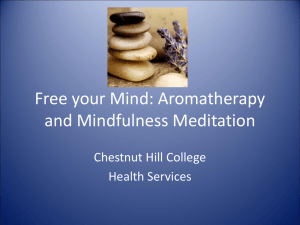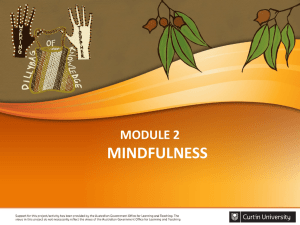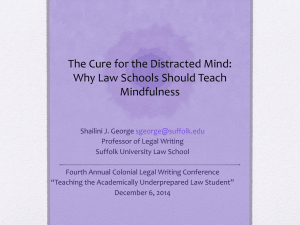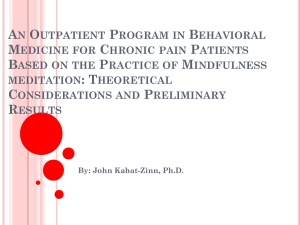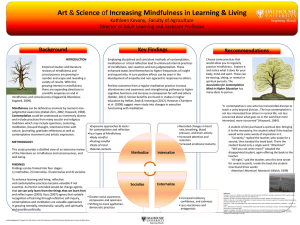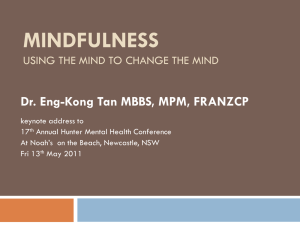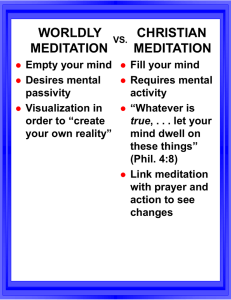HERE - Chicago State University
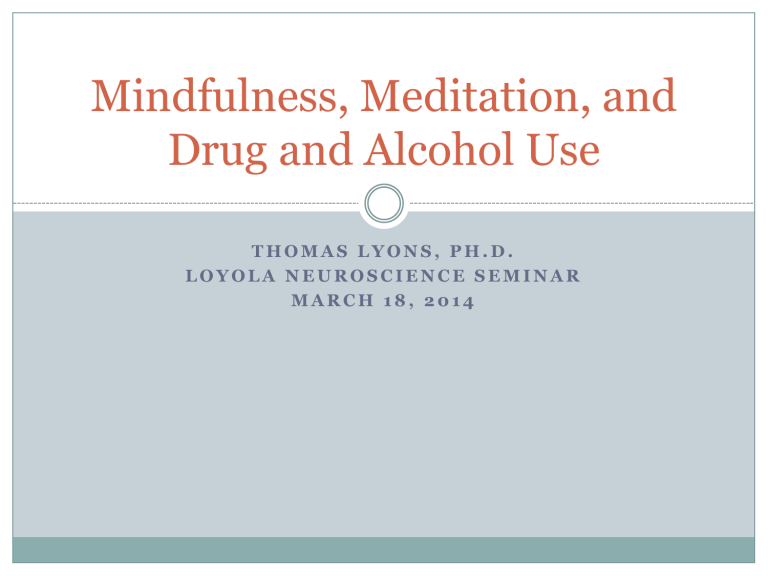
Mindfulness, Meditation, and
Drug and Alcohol Use
T H O M A S L Y O N S , P H . D .
L O Y O L A N E U R O S C I E N C E S E M I N A R
M A R C H 1 8 , 2 0 1 4
Mindfulness, Meditation and Drug and Alcohol
Use
What is mindfulness?
Enhancement of mindfulness through meditation training
Neurobiology of meditation and drug addiction
Mindfulness Based Relapse Prevention
Addiction and the criminal justice system: mindfulness programs in jails and prisons
Research program at Chicago State University
Summary and conclusions
“Life is available only in the present moment.”
― Thích Nh ấ t H ạ nh
What is mindfulness?
“Paying attention in a particular way; on purpose, in the present moment, and non-judgmentally.”
(Kabat-Zinn)
Attention to thoughts, emotions and feelings in the present moment
Attitude of acceptance/non-reactivity and non-judgement
A very old concept
Sati in Sanskrit means “awareness”, also remembrance, an important concept in Buddhism
Came into Western languages in the 1970s through work of
Vietnamese monk Thich Nhat Hanh and others
What is mindfulness?
Can be conceptualized as
A mental state that varies from moment to moment in an individual
A personality trait or disposition perduring over time that can be measuring with personality inventories
The goal of mindfulness practice
Five Facets Mindfulness Questionnaire
(Baer et al
2006)
Dispositional Mindfulness
Dispositional mindfulness is associated with adaptive functioning
(Baer et al 2006).
Anxiety levels and history of depression (Grossman et al 2004) less severe gambling outcomes (Lakey et al 2007) .
diabetes self-management (Gregg et al 2007).
Many other cross-sectional studies
Difficulties with the construct of mindfulness as a trait
(Grossman 2011)
Self reports may not be accurate
Experienced meditators may be more aware of their own limitations and rate themselves as less mindful
Dispositional Mindfulness and Drug/Alcohol Use
Among college age drinkers, relationship to alcohol use is
“paradoxical” (Eisenlohr-Moul et al 2012)
Higher levels of awareness
Lower levels of non-reactivity
Lower levels acting with awareness
Sample in drug treatment
(Bowen and Enkema, 2014)
Mindfulness inversely related to severity of dependence
Cultivating Mindfulness
Meditation
Types of meditation
Concentration or focused meditation, including TM
Insight or mindfulness meditation
Certain types of Hatha Yoga
Insight Meditation
Various eastern traditions including Zen, Vipassana and Tibetan traditions can be grouped under mindfulness meditation
Often builds from awareness of the breath to awareness of the whole field of phenomena at the present moment
Can include sitting, walking meditation
Short demonstration: Mindfulness Based Cognitive
Therapy (0:39:00)
Several short term or medium term interventions but for many, a lifetime practice http://www.youtube.com/watch?v=6-91LUJZoHo
Neurobiology of meditation
Types of studies:
Measurement of brain state changes during meditation vs. rest or other activities
Cross sectional comparison between long term meditators, short term participants in interventions, and/or nonmeditation control groups
Neural correlates of meditation/mindful states in these groups
Or response to a stimulus such as pain stimulus, emotional triggers
Longitudinal studies before and after meditation training
Comparisons to control group
Neurobiology of meditation
Structural vs. functional studies
Healthy samples vs. clinical samples (with symptoms of depression, addiction etc)
Evidence from EEG, PET, fMRI, and SPECT
Multiple brain structures affected
Prefrontal cortex
Somatosensory regions
Dorsolateral PFC
Hippocampus
Insulae
Amygdala
Functional networks
Eg insula plus somatosensory regions
Cortex plus limbic system
Neurobiology of meditation
Cross sectional comparison of long term meditator vs non meditators show enhanced activity in the PFC, right anterior insula and right hippocampus
(Chiesa &
Seretti, 2010)
Eight week meditation training increases grey matter density in hippocampus, cerebellum compared to controls
(Hölzel et al 2010)
Specific or non-specific effect?
Mindfulness Meditation as a Behavioral Therapy
“Third wave” of therapeutic interventions based on
acceptance of negative thoughts and emotions rather than attempts to manage or control them.
Mindfulness-based Stress Reduction for chronic pain (Kabat-
Zinn 1980)
Acceptance and Commitment Therapy for depression and anxiety (Hays et al 2006)
Mindfulness-based Cognitive Therapy for depression (Segal et al 2002)
Dialectical Behavior Therapy for borderline personality disorder (Hays et al 2004)
Possible mechanisms of clinical benefit
Strengthening connectivity between the cortex and limbic system
(Chiesa, 2013)
Dampen automatic amygdala activation
stress response,
anxiety and other emotional states
pain perception
May be interpreted as an increased conscious control
Increasing grey matter density in specific regions
(Hö lzel et al 2010)
Before meditation, high emotional reactivity is observed. The amygdala easily activates in response to negative stimuli and the PFC is not able to inhibit the amygdala. (Chiesa et al. 2010)
After meditation training, amygdala activity is usually reduced. If amygdala activates in response to negative stimuli,
PFC is engaged in order to dampen automatic amygdala responses. (Chiesa et al 2010)
Neurobiology of addiction
Effect of drugs of abuse is related to the mesolimbic reward system: ventral tegmental area, ventral striatum, amygdala and medial PFC – the “reward circuit”.
Compulsive use also involves the dorsal striatum –
“habit circuit”
Addiction also involves dysfunction in the cortex, including dlPFC and activation of subgenual ACC
Effect of mindfulness meditation training
Mindfulness training primarily targets the cortex; at least initially, a “top down” process of improving control over functioning
Self referential thinking and rumination activate midline PFC areas in both depression and addiction
(Brewer et al. 2009)
Mindfulness practice may shift activation from midline PCC to dlPCC – more objective awareness
Lateralization of brain activation
Effect of a brief mindfulness meditation training
47 treatment-seeking smokers (12-h abstinent from smoking) viewed images while undergoing fMRI
(Westbrook et al 2011).
Passively vs. trained to engage in mindful attention
Mindful attention reduced neural activity in subgenual anterior cingulate cortex (sgACC)
Reduced connectivity with other craving related regions including insula and ventral striatum
Also reduced self-reported craving
(Westbrook et al. 2011)
Effect of a brief mindfulness meditation training
47 treatment-seeking smokers (12-h abstinent from smoking) viewed images while undergoing fMRI
(Westbrook et al 2011).
Passively vs. trained to engage in mindful attention
Mindful attention reduced neural activity in subgenual anterior cingulate cortex (sgACC)
Reduced connectivity with other craving related regions including insula and ventral striatum
Also reduced self-reported craving
(Westbrook et al. 2011)
Top-down or bottom-up process?
Experienced meditators exhibit changes in limbic system functioning during meditation that are independent of cortical control
.(Chiesa et al 2013)
May depend on length of involvement in meditation
May depend on type of sample: healthy vs. clinical samples (eg smokers trying to quit)
Mindfulness Based Relapse Prevention
(Chawla et al
2011)
Based on Mindfulness Based Stress Reduction
An eight week course including meditation, yoga, and discussion of relapse, triggers, and relapse prevention
Designed for individuals coming out of drug treatment
Mindfulness Based Relapse Prevention
In a randomized controlled trial (RCT), significant reductions in substance use and craving were observed in the MBRP group compared to treatment as usual
(Bowen et al, 2009b)
A second RCT compared mindfulness meditation to cognitive behavioral therapy for substance use and found reduced craving and physiological stress indices in the treatment group
(Zgierska et al 2010)
Mindfulness Based Relapse Prevention
Might have particularly long-lasting effects on reducing drug use (Zgierska et al 2009).
However, strong evidence for effectiveness of mindfulness-based treatment for substance use disorders is still lacking. (Zgierska et al 2009)
Difficulties with MM in drug treatment
Anxiety in early withdrawal
(Vallejo et al 2009)
Restlessness/agitation
History of trauma
An adjunct, not a substitute for drug treatment
May require a period of abstinence from substances
Research at Chicago State University
Urban Mindfulness and Addictions Research
MBRP in jail drug treatment
Mindfulness with case managers: enhancing the working alliance and therapeutic outcomes
Mindfulness, substance abuse, and medication adherence
Drug discovery program as adjunct to mindfulness therapy
Addiction and the Criminal Justice System
More than 60% of prisoners are estimated to have a substance use disorder(National Center on Addiction and Substance Abuse 2010)
In Cook County the majority of detainees are charged with low level drug offenses(Lyons et al 2013)
Addiction and the Criminal Justice System
Five fold growth in incarceration rates among people of color since 1980 has largely been a result of drug related arrests and convictions(Alexander 2010).
African Americans are 54% of those incarcerated for drug offenses and are 10 times more likely than whites to be sentenced to prison for a drug law violation(Human Rights Watch 2000).
Cycles of repeated arrest and imprisonment for drug related crimes often reflect untreated addiction(Langan and Levin 2002).
Addiction and the Criminal Justice System
Much mindfulness meditation research has been with white, middle class patients.
No studies of mindfulness meditation that focus on cultural adaptations for African American men.
Meditation training in a jail context
Limited in duration
Linked to post-release services
Participants should be over the acute withdrawal stage
Why meditation programs in jail?
7x as many individuals released annually from jails as from prisons
Many jails have existing drug treatment programs
Enforced abstinence may promote benefit of mindfulness training
Mindfulness training may promote engagement in aftercare
Goals of the study
Culturally tailor the MBRP intervention for an urban, primarily African American population of inmates
Test efficacy via a quasi-experimental clinical trial within a men’s drug treatment program at the Cook
County Jail.
Goals of the study
At 5-month intervals over the course of 36 months, successive cohorts will be given either mindfulness training or an attention control communication skills intervention.
Pre- and post-test assessments, at an equivalent interval, of mindfulness, psychological symptoms, and PTSD symptoms.
Participants in the experimental condition will be referred to post-release meditation groups
Goals of the study
To assess the efficacy of the intervention,
rearrest and reincarceration data will be compared for the treatment and control groups at a minimum of 12 months post release.
Contact participants by telephone 3 months post release and obtain self reported substance use data qualitative interviews with a subset of participants in the experimental group one month post-release will explore whether and how they implemented mindfulness
Formative research to adapt intervention
Focus group
Working with African American, culturally competent trainers
Adapting and simplifying manual Mindfulness Based
Relapse Prevention: A Clinician’s Guide (Chawla et al. 2011)
Some conclusions
Mindfulness as an attentional state, personality trait, and goal of meditation practice
As a trait, mindfulness is probably important for understanding addiction, but research is just beginning
Related to deficits in executive functioning, impulsiveness, and sensation seeking
Some conclusions
Meditation practice changes brain structure and functional circuits
Most studies cross sectional and involve small samples
Prospective studies with appropriate control groups needed
Meditation training may be a potent tool in drug addiction treatment
May have long lasting effects
Stage and context of recovery important
Linking behavioral and pharmacological treatment
Thank you!
t l y o n s 2 0 @ c s u . e d u
References
Alexander, M. (2010). The new Jim Crow: Mass incarceration in the age of colorblindness. New York: New Press.
Baer, R. A., Hopkins, J., Krietemeyer, J., Smith, G. T., & Toney, L. (2006). Using self-report assessment methods to explore facets of mindfulness. Assessment, 13(1), 27-45.
Bowen, S., & Enkema, M. C. (2014). Relationship between dispositional mindfulness and substance use: Findings from a clinical sample. Addictive Behaviors, 39, 3, 532-537.
Bowen S, Marlatt A. (2009a) Surfing the Urge: Brief Mindfulness-Based Intervention for College Student Smokers. Psychology of
Addictive Behaviors 2009;23(4):666-671.
Bowen S., Chawla N., Collins S.E., Hsu S., Grow J., Clifasefi S., et al. (2009b) Mindfulness-based relapse prevention for substance use disorders: A pilot efficacy trial. Substance Abuse 2009;30(4):295-305.
Chiesa A., Serretti A. A systematic review of neurobiological and clinical features of mindfulness meditations. Psychological
Medicine 2010;40(8):1239-1252.
Chiesa A, Serretti A, Jakobsen JC. Mindfulness: Top–down or bottom–up emotion regulation strategy? Clinical Psychology
Review 2013;33(1):82-96.
Eisenlohr-Moul T.A., Walsh E.C., Charnigo Jr. R.J., Baer R.A., Lynam D.R. The "What" and the "How" of Dispositional
Mindfulness: Using Interactions Among Subscales of the Five-Facet Mindfulness Questionnaire to Understand Its Relation To
Substance Use. Assessment 2012;19(3):276-286. 29
Gregg, J., Callaghan, G. Improving diabetes self-management through acceptance, mindfulness and values: A randomized controlled trial. Journal of Consulting and Clinical Psychology. 2007. Vol. 75. No. 2 336-343.
Grossman P, Niemann L, Schmidt S, Walach H. Mindfulness-based stress reduction and health benefits. A meta-analysis. J
Psychosom Res. 2004 Jul; 57(1):35-43.
Grossman, P., & Van, D. N. T. (May 01, 2011). Mindfulness, by any other name…: trials and tribulations of sati in western psychology and science. Contemporary Buddhism, 12, 1, 219-239.
Hayes SC, Luoma JB, Bond FW, Masuda A, Lillis J. Acceptance and Commitment Therapy: Model, processes and outcomes. Behav
Res Ther 2006;44(1):1-25.
Hayes SC, Follette VM, Linehan M. Mindfulness and acceptance : expanding the cognitive-behavioral tradition. New York:
Guilford Press; 2004.
References
Hö lzel, B. K., Carmody, J., Vangel, M., Congleton, C., Yerramsetti, S. M., Gard, T., & Lazar, S. W. (January 01, 2011). Mindfulness practice leads to increases in regional brain gray matter density. Psychiatry Research, 191, 1, 36-43
Human Rights Watch. Punishment and prejudice: Racial disparities in the war on drugs. 2000. Retrieved from http://www.hrw.org/reports/2000/05/01/punishment-and-prejudice-racial-disparities-war-drugs
Kabat-Zinn J. An outpatient program in behavioral medicine for chronic pain patients based on the practice of mindfulness meditation: theoretical considerations and preliminary results. Gen Hosp Psychiatry 1982;4(1):33-47.
Lakey, Campbell, W., Brown, K. Goodi, A. Dispositional mindfulness as a predictor of the severity of gambling outcomes.
Personality and Individual Differences. 2007. Vol. 43: 1698–1710
Langan PA, Levin DJ, United States. Bureau of Justice Statistics. Recidivism of prisoners released in 1994. 2002; .
National Center on Addiction and Substance Abuse. Behind bars II : substance abuse and America's prison population. New
York, NY: National Center on Addiction and Substance Abuse at Columbia University; 2010.
Lyons T, Lurigio A, Roque L, Rodriguez P. Racial Disproportionality in the Criminal Justice System for Drug Crimes: A State
Legislative Response to the Problem. Race and Justice 2013;3(1):83-101.
Segal ZV, Williams JMG, Teasdale JD. Mindfulness-based cognitive therapy for depression : a new approach to preventing relapse. New York: Guilford Press; 2002.
Thorsten, B., Duggan, D., Griffith, J. Dispositional mindfulness moderates the relation between neuroticism and depressive symptoms. Pers Individ Dif. 2011 December; 51(8): 958–962.
Vallejo Z, Amaro H. Adaptation of Mindfulness-Based Stress Reduction Program for Addiction Relapse Prevention. Humanistic
Psychologist 2009;37(2).
Westbrook C, Creswell JD, Tabibnia G, Julson E, Kober H, Tindle HA. Mindful attention reduces neural and self-reported cueinduced craving in smokers. Social Cognitive and Affective Neuroscience 2011(12).
Zgierska A., Rabago D., Kushner K., Chawla N., Marlatt A., Koehler R. Mindfulness meditation for substance use disorders: A systematic review. Substance Abuse 2009;30(4):266-294.
